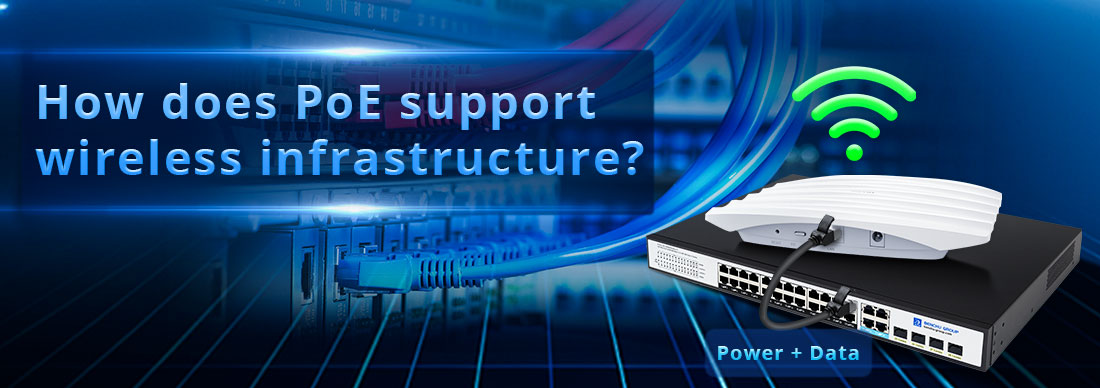
Power over Ethernet (PoE) plays a critical role in supporting wireless infrastructure by providing both power and data connectivity to wireless devices such as wireless access points (APs), routers, and wireless bridges. Here’s how PoE contributes to wireless infrastructure:
1. Simplified Installation
No Need for Separate Power Outlets: PoE enables wireless access points and other wireless devices to be powered through the Ethernet cable, eliminating the need for power outlets near each device. This is particularly useful in locations where installing power outlets would be difficult or costly, such as ceilings, outdoor areas, or remote locations.
Flexible Placement: Since PoE supplies power through Ethernet cables, wireless APs can be positioned in optimal locations for coverage and performance without being constrained by the availability of electrical outlets.
2. Centralized Power Management
Remote Power Control: Using a managed PoE switch, IT administrators can remotely power cycle wireless APs, monitor power consumption, and control devices without needing physical access to them. This centralized control allows for efficient network management, especially in large or multi-site wireless networks.
Power Budgeting: Managed PoE switches help manage the power budget across devices, ensuring that each wireless AP receives the necessary power for stable operation, even when network demands change or new devices are added.
3. Scalability and Flexibility
Easier Network Expansion: As wireless infrastructure grows to meet increasing user demand, PoE enables easy deployment of additional access points or wireless devices without extensive electrical rework. This makes scaling up the network much simpler and more cost-effective.
PoE++ for High-Power Devices: The latest PoE standards (PoE++ or IEEE 802.3bt) can deliver up to 60-100W of power, allowing more advanced, high-performance wireless devices, such as multi-gigabit access points, to operate efficiently.
4. Increased Reliability and Redundancy
Uninterrupted Power Supply (UPS) Integration: PoE systems can be connected to a UPS, ensuring that wireless APs and network infrastructure continue operating even during power outages. This enhances network reliability, particularly in environments where consistent wireless access is critical, such as hospitals, offices, or manufacturing facilities.
Automatic Power Failover: Many PoE switches have redundancy features, allowing for automatic failover to backup power in case of a primary power failure. This minimizes downtime and keeps the wireless network running smoothly.
5. Enhanced Wireless Performance
Improved Wireless Coverage: PoE supports the deployment of multiple wireless APs across a facility, ensuring robust and wide-reaching Wi-Fi coverage. More access points reduce the likelihood of coverage dead zones and provide better load balancing, resulting in improved wireless performance for users.
Seamless Roaming: With PoE-powered APs, it's easier to position them in strategic locations, creating seamless wireless handoff zones where users can roam without losing connectivity or experiencing performance drops.
6. Cost-Efficiency
Lower Infrastructure Costs: By combining power and data delivery into one Ethernet cable, PoE reduces the cost of installing additional electrical wiring, conduits, and outlets. This saves on labor and materials, especially in large-scale deployments or retrofits.
Energy Efficiency: PoE can deliver power only when necessary, allowing for more energy-efficient operations. Devices can be scheduled to power down during off-peak times, further reducing operating costs.
7. Support for Outdoor and Remote Wireless APs
Extended Reach: Using PoE extenders or midspan injectors, wireless APs can be installed at distances beyond the standard Ethernet limit of 100 meters, which is particularly useful for deploying outdoor wireless devices.
Rugged Environments: PoE is suitable for outdoor or industrial wireless deployments, as it minimizes the need for additional electrical wiring and ensures reliable operation in challenging or remote environments.
8. Support for IoT and Smart Devices
PoE Integration for IoT: In wireless infrastructure setups, PoE can power IoT devices such as sensors, security cameras, and smart lighting systems that connect to the wireless network. This creates a cohesive, efficient, and centrally managed wireless ecosystem.
In conclusion, PoE significantly supports wireless infrastructure by enabling the efficient, scalable, and flexible deployment of wireless devices while reducing the complexity and cost of installation and management. It enhances network reliability, simplifies device placement, and improves overall wireless performance, making it a key component of modern wireless networks.